Lipoprotein:- Part 5 – Triglycerides (TG)
Triglycerides (TG)
What sample is needed for Triglycerides (TG)?
- This is done ideally on the patient’s fasting serum. Venous blood is taken.
- Fasting for 12 to 14 hours is required.
- Plasma with EDTA can be used.
- The sample is stable at 4 °C for 7 days and at -20 °C for 3 months.
- If plasma is used, then multiply the result by 1.03.
What are the precautions for Triglycerides (TG)?
- Patients must have at least fasting for 12 hours.
- If TG in males is> 160 mg/dL and females is> 135 mg/dL, two more samples should be taken in the next 6 to 8 weeks.
- Intake of the fatty meal may increase the TG.
- Alcohol intake increases TG.
- In pregnancy, the TG level is raised.
- Take H/O drubs like oral contraceptives and estrogen to increase the TG level.
- Take H/O ascorbic acid, clofibrate, and colestipol to decrease the TG level.
What are the indications for Triglycerides (TG)?
- This is done to evaluate the causes of atherosclerosis (Coronary artery disease).
- This is done to evaluate the turbid serum (milky).
- Triglyceride is part of the lipid profile.
- Triglyceride is advised in a patient with a suspected fat metabolism disorder.
How will you define Triglyceride (TG)?
- Triglyceride (TG) is primarily found in chylomicrons and VLDL.
- Triglyceride (TG) provides a reasonable estimate of VLDL.
- Triglycerides are good risk factors for coronary heart disease, which is controversial.
How will you discuss the pathophysiology of Triglycerides (TG)?
Source of Triglyceride:
- Plants contain polyunsaturated fatty acids.
- Corn.
- Sunflower.
- Safflower.
- The animal source contains primarily saturated fatty acids and solids at room temperature.
- Glucose must be present in the cells for the formation of TG.
- One of the sources gives the following ratio of triglycerides in various fats.
How will you describe the structure of Triglyceride?
- TG consists of three fatty acids + one molecule of glycerol by ester bond, so-called Triglycerides.
- Glycerol and fatty acids are building blocks for TG.
- Three fatty acids + one molecule of glycerol (ester bond) = Triglyceride
- TG is present in the blood and transported by the VLDL and LDL.
- The glycolytic pathway in glucose catabolism leads to triglyceride formation.
- This triglyceride formation may be absent in the case of:
- Fasting.
- Starvation.
- Uncontrolled diabetes mellitus.
How will you discuss Triglyceride catabolism?
- TG, when catabolized, forms a small fraction of free fatty acid, which appears in plasma bound to albumin.
- These nonesterified fatty acids, after oxidation, enter the Acetyl CoA cycle.
- The end result is water, CO2, and ATP, the energy source.
How are the Triglycerides (TG) stored in the body?
- Triglycerides (TG) are the fat in the bloodstream.
- Triglycerides (TG) account for more than 90% of the food intake and are 95% of the fat stored.
- Triglycerides (TG) are insoluble in water; this is the main glycerol ester.
- TG is stored in adipose tissue as :
- Glycerol.
- Fatty acids.
- Monoglyceride.
- The liver is the factory to convert all the above into triglycerides.
- Triglycerides (TG) are Transported and present in :
- 80% are in VLDL.
- 15% are in LDL.
- TG is the source of energy.
- When TG is high, it starts depositing in fatty tissue.
- The Fredrickson-Levy classification method for hyperlipidemia: Refrigerate the plasma at 4 °C for 16 hours, and then observe the creamy layer at the top of turbidity.
- This can be completed by doing a lipid profile.
What is the normal Triglycerides (TG)?
Source 1
| Age | Male mg/dL | Female mg/dL |
| Cord blood | 13 to 95 | 11 to 76 |
| 0 to 9 year | 30 to 100 | 35 to 110 |
| 10 to 14 year | 32 to 125 | 37 to 131 |
| 15 to 19 year | 37 to 148 | 39 to 124 |
| 20 to 24 year | 44 to 201 | 36 to 131 |
| 25 to 29 year | 46 to 249 | 37 to 144 |
| 30 to 34 year | 50 to 266 | 39 to 150 |
| 35 to 39 year | 54 to 321 | 40 to 176 |
| 40 to 44 year | 55 to 320 | 45 to 191 |
| 45 to 49 year | 58 to 327 | 46 to 214 |
| 50 to 54 year | 58 to 320 | 52 to 233 |
| 55 to 59 year | 58 to 286 | 55 to 262 |
| 60 to 64 year | 58 to 291 | 56 to 239 |
| >65 year | 55 to 260 | 60 to 240 |
- To convert into SI unit x 0.0113 = mmol/L
- The recommended cutoff point for evaluating triglyceridemia status:
- Normal = <250 mg/dL
- Borderline high = 250 to 500 mg/dL
- Hypertriglyceridemic = >500 mg/dL
- High risk for pancreatitis = >1000 mg/dL
Source 2
- Male Adult = 40 to 160 mg /dL.
- Female Adult = 35 to 135 mg /dL.
| Children | Male mg/dL | Female mg/dL |
| 0 to 5 years | 30 to 86 | 32 to 99 |
| 6 to 11 years | 33 to 108 | 35 to 114 |
| 12 to 15 years | 36 to 138 | 41 to 138 |
| 16 to 19 years | 40 to 163 | 40 to 128 mg |
Critical values of triglycerides are:
- Desirable = < 150 mg /dL.
- Borderline high = 150 to 199 mg /dL.
- High = 200 to 499 mg /dL.
- Very high = > 500 mg /dL.
- Critical value >400 mg/dL
Triglycerides (TG) concentration, according to the National Cholesterol Education Program:
(Adult treatment panel (NECP-ATP II).
| Risk factor | Serum Triglyceride mg/dL |
| Normal | <200 |
| Borderline | 200 to 400 |
| High | 400 to 1000 |
| Very high | >1000 |
What are the causes of increased Triglyceride values?
- Hyperlipidemia.
- Hyperlipoproteinemia.
- Nephrotic syndrome.
- Liver diseases.
- Alcoholism (alcoholic cirrhosis).
- Diabetes Mellitus, uncontrolled.
- Glycogen storage disease (Von Gierke disease).
- Familial hypertriglyceridemia.
- Hypothyroidism.
- Gout.
- Anorexia nervosa.
- Down’s syndrome.
- Myocardial infarction.
What are the causes of decreased triglyceride levels?
- Malnutrition.
- Hyperthyroidism.
- Congenital α-β- lipoproteinemia.
- Malabsorption.
How will you manage Hypertriglyceridemia?
- If Triglycerides (TG) are < 200 mg/dL, then the person needs diet control, and he should be advised to repeat triglyceride once a year.
- If Triglycerides (TG) are 200 to 500 mg/dL, then evaluate the patient with risk factors like:
- Diabetes mellitus
- Alcoholism
- Hypothyroidism
- Hypertension
- Hyperuricemia
- Medication like beta-blockers, Estrogen, corticosteroids, and oral contraceptives.
- Diseases like kidney and pancreatitis.
- No above risk factors in a person need only diet control
- Positive above risk factors and family history in a person, these people need diet and medication.
What are the critical values of Triglyceride?
- If a person’s triglyceride is >500 mg/dL, these patients need diet control and medication.
Table showing the summary of characteristics of the lipoproteins:
| Characteristics | Chylomicron | HDL | LDL | VLDL |
| Size (diameter nm) | >70.0 | 4 to 10 | 19.6 to 22.7 | 25 to 70 |
| Electrophoretic mobility | Origin | α – region | β – region | Pre – β region |
| Molecular weight | 0.4 to 30 x 109 | 3.6 x 109 | 2.75 x 109 | 5 to 10 x 109 |
| Synthesized in | Intestine | Intestine and liver | Intravascular | Liver and intestine |
| Composition by weight in % | ||||
| Cholesterol esterified | 5 | 38 | 49 | 11 to 14 |
| Cholesterol unesterified | 2 | 10 | 13 | 5 to 8 |
| Triglycerides | 84 | 9 | 11 | 44 to 60 |
| Phospholipids | 7 | 22 | 27 | 20 to 23 |
| Proteins | 2 | 21 | 23 | 4 to 11 |
Questions and answers:
Question 1: What is the critical value of the triglycerides?
Question 2: What is the role of VLDL in case of triglycerides?

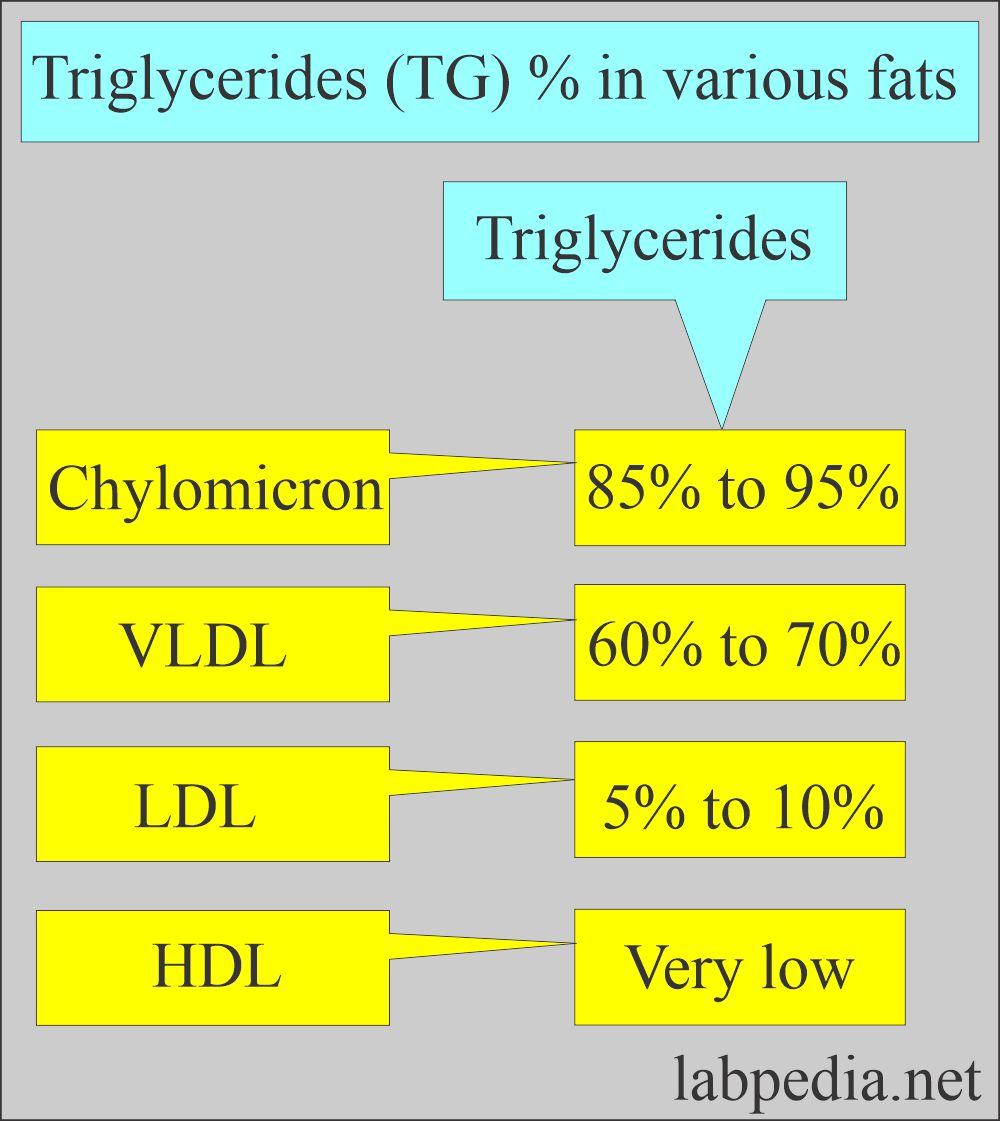
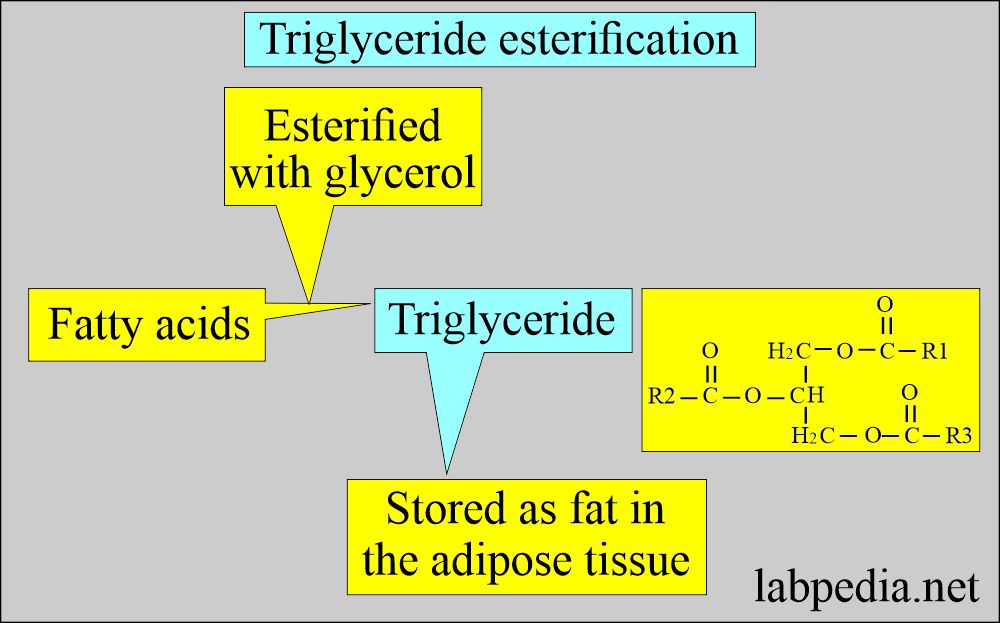
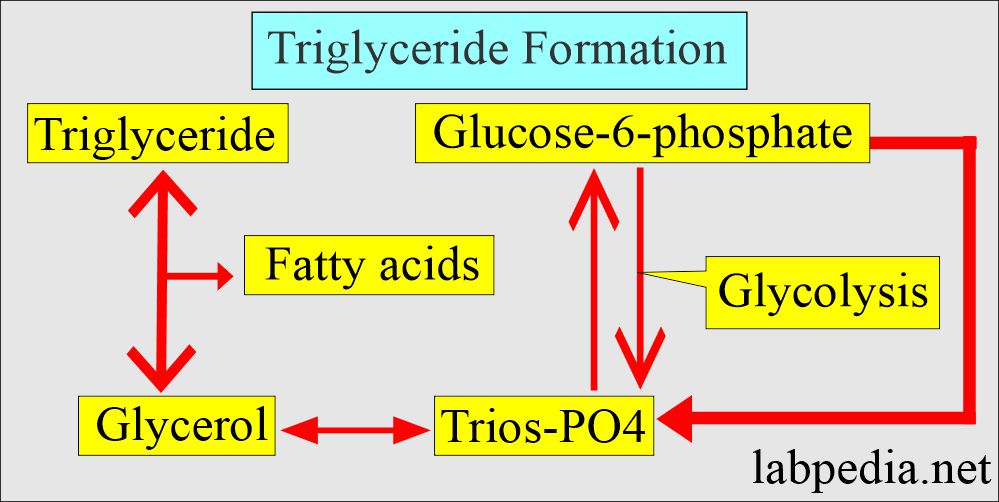
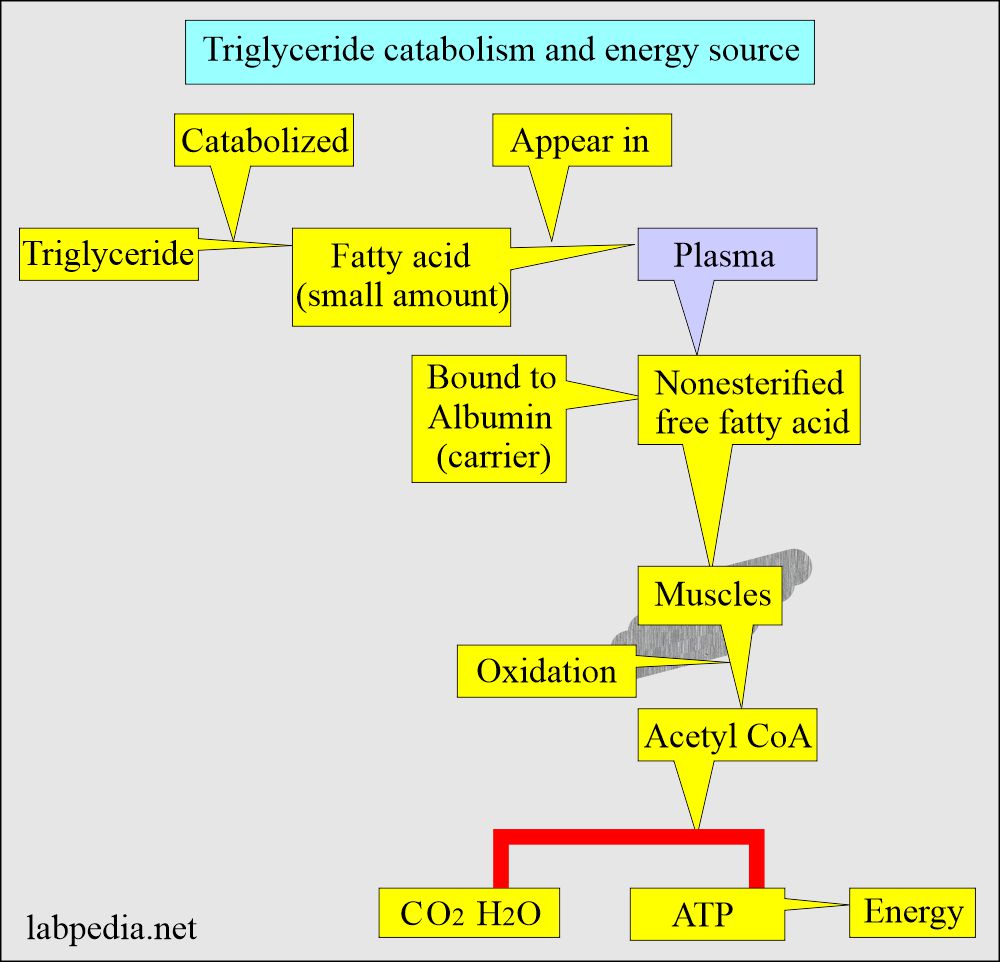
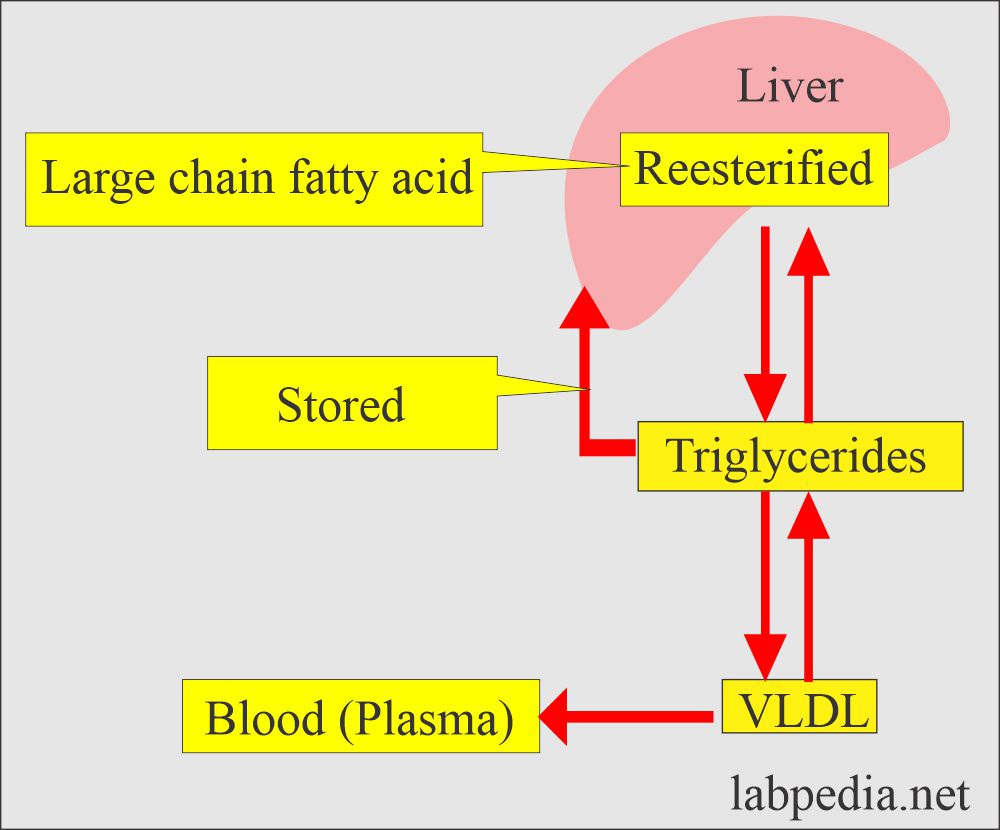
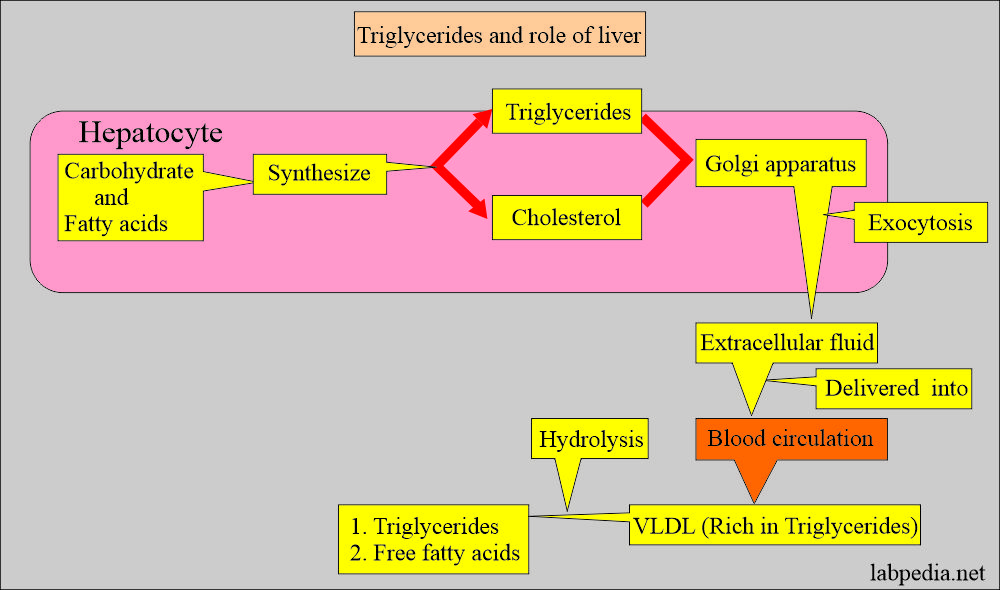
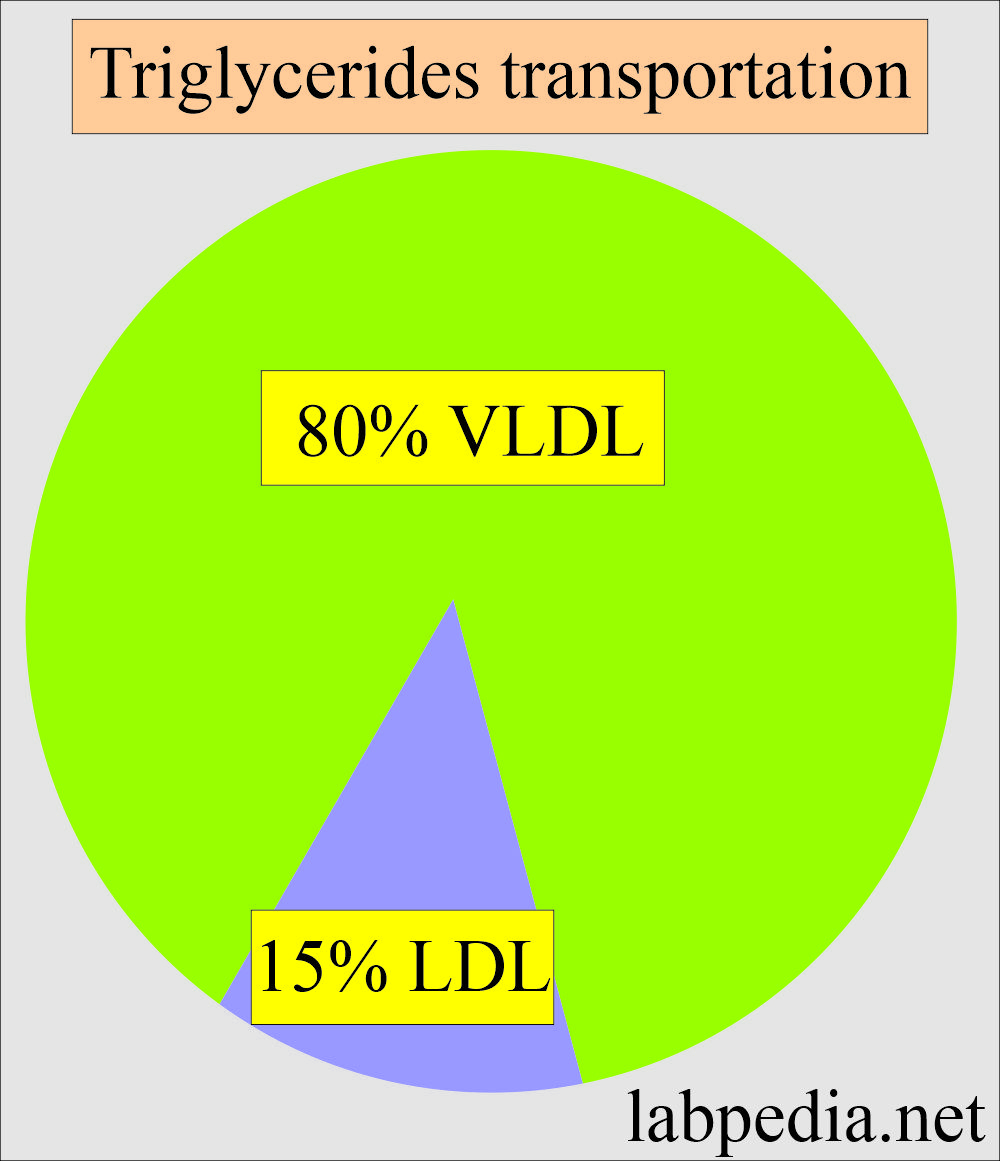
Thank you so much
Thanks.